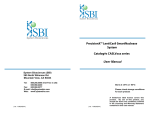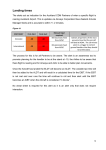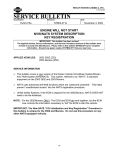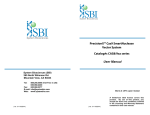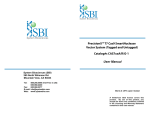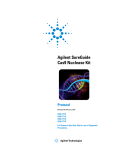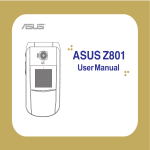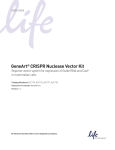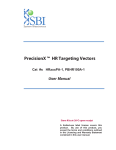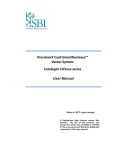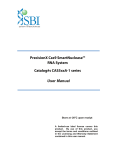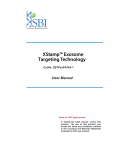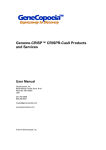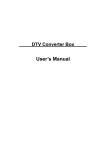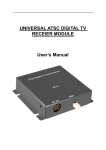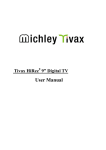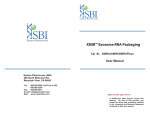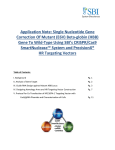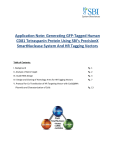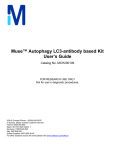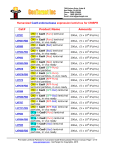Download User Manual - System Biosciences
Transcript
PrecisionX™ LentiCas9 SmartNuclease System Catalog#s CASLVxxx series User Manual System Biosciences (SBI) 265 North Whisman Rd. Mountain View, CA 94043 Tel: 888.266.5066 (Toll Free in US) 650.968.2200 Fax: 650.968.2277 E-mail: [email protected] Web: www.systembio.com Store at -20°C or -80°C Please check storage conditions for each product A limited-use label license covers this product. By use of this product, you accept the terms and conditions outlined in the Licensing and Warranty Statement contained in this user manual. PrecisionX™ Lenti-Cas9 System Cat#CASLVxxx Contents I. Introduction........................................................................ 2 A. Overview of CRISP R/Cas9 system ..................................... 2 B. Product Information ........................................................... 5 C. Vector Information ............................................................. 7 D. Validation Dat a for Lenti-Cas9 SmartNuclease™ and Nickase Vectors ............................................................................... 11 E. Key Advantages of the Lenti-Cas9 SmartNuclease™ and SmartNickase System .......................................................... 13 F. Applications of the Lenti-Cas9 SmartNuclease™ and SmartNickase Expression System ........................................ 14 G. List of Components ......................................................... 15 H. Additional Materials Required ........................................... 17 I. Related Products .............................................................. 18 J. Shipping and Storage Conditions ...................................... 18 II. Protocol for the Lenti -Cas9 Expression System .................. 19 A. Overview of the Prot ocol .................................................. 19 B. Selection of Target DNA Sequence................................... 20 C. Design of Guide RNA Oligonucleotides ............................. 21 D. Cloning into the gRNA Lentivector .................................... 22 E. Packaging of Lentivector Constructs ................................. 23 F. Concentration of Pseudoviral Particles .............................. 24 G. Transduction of Pseudoviral Particles into Target Cells ...... 26 H. Generation of Stable Cas9/nickase Cell Line ..................... 27 III. Frequently Asked Questions .......................................... 29 888-266-5066 (Toll Free) 650-968-2200 (outside US) Page 1 System Biosciences (SBI) I. User Manual IV. Referenc es ................................................................... 32 V. Technical Support ......................................................... 33 VI. Licensing and Warranty information ............................... 34 Introduction A. Overview of CRISPR/Cas9 system In the past decade, a great deal of progress has been made in the field of t argeted genome engineering. Technologies such as designer zinc finger nucleases (ZFNs), transcriptional activator-like effector nucleases (TALE Ns), and homing meganucleases have made site-specific genome modifications a reality in many different model organisms ranging from zebrafis h to mammalian cells . Based on the results to date, however, genome editing tools that are efficient, flexible, and cost-effective have remained elusive to the general research community. The recent discovery of the type II prokaryotic CRISPR (Clustered Regularly Interspaced Short Palindromic Repeats) system, originally discovered in the bacterium Streptococcus pyogenes as a mechanism to defend against viruses and foreign DNA, has provided y et another tool for target ed genome engineering, this time taking advantage of a system that uses small RNAs as guides to cleave DNA in a sequence-specific manner. With its ease in designing guide sequences to target specific sequences (unlike ZFNs and TA LENs where construct assembly can be laborious and time-consuming), as well as its targeting efficiency, this system has the potential to be a disruptive technology in the field of genome -engineering. The CRISPR/CRISPR-associated (Cas ) system involves 1) retention of foreign genetic material, called “spacers”, in clustered arrays in the host genome, 2) expression of short guiding RNAs (crRNAs) from the spacers, 3) binding of the crRNAs to specific portions of the foreign DNA called prot ospacers and 4) Page 2 ver. 2-150123 www.systembio.com PrecisionX™ Lenti-Cas9 System Cat#CASLVxxx degradation of protospac ers by CRISPR-associated nucleases (Cas ). A well-characterized Ty pe II CRISP R system has been previously described in t he bacterium Streptococcus pyogenes, where four genes (Cas9, Cas1, Cas2, Csn1) and two non-c oding small RNAs (pre-crRNA and t racrRNA ) act in concert to target and degrade foreign DNA in a sequence-specific manner [Jinek et. al. 2012]. The specificity of binding t o the foreign DNA is cont rolled by the non-repetitive spacer elements in the pre -crRNA, which upon transcription along wit h the tracrRNA, directs the Cas9 nuclease to the protos pacer:crRNA heteroduplex and induces double-strand breakage (DSB) formation. Additionally, the Cas9 nuclease cuts the DNA only if a specific sequence known as protospacer adjacent motif (PAM) is present immediately downstream of the protospacer sequence, whose canonical sequence in S. pyogenes is 5’ - NGG -3’, where N refers to any nucleotide. 888-266-5066 (Toll Free) 650-968-2200 (outside US) Page 3 System Biosciences (SBI) User Manual Figure 1: Overview of the CRISP R system. Figure adapted from Cong et al. “Multiplex Genome Engineering Using CRISPR/ Cas Systems”. Recently, it has been demonstrated that the expression of a single chimeric crRNA:tracrRNA transcript, which normally is expressed as two different RNAs in the native type II CRISPR system, is sufficient to direct the Cas9 nuclease to sequence-specifically cleave target DNA sequences. By adapting the endogenous type II CRISP R/Cas system in S. pyogenes for utility in mammalian cells, several groups have independently shown that RNA -guided Cas9 is able to efficiently introduce precise double stranded breaks at endogenous genomic loci in mammalian cells with high efficiencies and minimal off-target effects [Cong et al. 2013, Mali et al. 2013, Cho et al. 2013]. Page 4 ver. 2-150123 www.systembio.com PrecisionX™ Lenti-Cas9 System Cat#CASLVxxx In addition, several mutant forms of Cas 9 nuclease have been developed to take advantage of their features for additional applications in genome engineering and transcriptional regulation Biochemical characterization of a mutant form of Cas9 nuclease (D10A) functions as a nickase (Jinek et al. 2012), generating a break in the complementary strand of DNA rather than both strands as with the wild-type Cas 9. This allows repair of the DNA template using a high-fidelity pathway rat her than NHEJ, which prevents formation of indels at the targeted locus, and possibly other locations in the genome to reduce possible off-target/toxicity effects while maintaining ability to undergo homologous recombination (Cong et al. 2013). Recently, paired nicking has been shown to reduc e off-target activity by 50- to 1, 500 fold in cell lines and to facilitate gene knockout in mouse zygote without losing on-target cleavage efficiency (Ran et al., 2013). Finally, tandem knockout of both RuvCI and HNH nuclease domains (whic h control cutting of the DNA strands ) shows that the nullnuclease mutant (double mutant) can act as a transcriptional repressor (Qi et al. 2013) with minimal off-target effects, which leads to possibilities for studying site-specific transcriptional regulation. Taken together, the RNA-guided Cas9 system defines a new class of genome engineering tools, creating new opportunities for research across basic sciences, biotechnology and biomedicine. B. Product Information Based on our industry-leading, trans fection-based, all-in-one Cas9 SmartNuclease and Smart Nickase plasmid systems, we have now adapted t hese constructs into a lentivector format. SB I’s LentiCas9 SmartNuclease system is ideal for targeting cell types that are t raditionally difficult to transfect with plasmids, effectively expanding the range of target cells amenable for CRISP R/Cas9based genome engineering. The Lenti-Cas9 system also provides an easy and efficient way to generate stable Cas9 editing cell 888-266-5066 (Toll Free) 650-968-2200 (outside US) Page 5 System Biosciences (SBI) User Manual lines. SBI offers lentiviral constructs in two formats: 1) An “all-inone” format expressing Cas9 and gRNA from a single vector and 2) a two vector system with separate Cas9 and gRNA expression vectors. All of the Cas9 lentivector constructs (Section I.C) express human-codon optimized Cas9 wild-type nuclease or mutant nickase, while the gRNA cloning/expression lentivector constructs (Section I.C) contain a pre-made tracrRNA scaffold with gRNA cloning sites driven by your choice of H1 or U6 Pol-III promoters for robust expression in a wide range of cells. The system is designed to accommo date flexible targeting of any genomic loci in the form of N20NGG; however, other gRNA formats (e.g. N17-18NGG) can be utilized as well. SBI offers pre-packaged, ready-t o-infect pseudoviral particles for expression of Cas9 wild-type nucleases and mutant nickases for generation of cell lines stably expressing Cas9. Pseudoviral particles have been packaged to exacting QC standards and comes with functional titer and in-house transduction dat a for each production lot of virus. For t hose customers wishing t o package any of the Lenti-Cas9 SmartNuclease lentivectors in their own lab, SBI offers the LentiStart er 2.0 kit, which contains all of the necessary reagents to produce high-quality virus and transduce target cells. The Kit is available as part of a bundl ed package with any Lenti-Cas9 vectors as well as a standalone item (SB I Cat #LV051A -1). Please refer to Section I.G for details regarding the LentiStarter 2.0 Kit. Page 6 ver. 2-150123 www.systembio.com PrecisionX™ Lenti-Cas9 System Cat#CASLVxxx C. Vector Information WT Cas9 and Nickase Lentivectors (T2A-Puro Format) 888-266-5066 (Toll Free) 650-968-2200 (outside US) Page 7 System Biosciences (SBI) User Manual WT Cas9 and Nickase Lentivectors (Dual Promoter EF1-GFP Format) Note: Above CAS LVxxxPA-1 catalog items are provided as 10 g of plasmid DNA. CAS LVxxxVA-1 catalog items are provided as 2 x 25 ul aliquots of pre-packaged, ready-to-infect lentivirus (> 10^7 IFUs/ml, >10^6 infectious units total). Page 8 ver. 2-150123 www.systembio.com PrecisionX™ Lenti-Cas9 System Cat#CASLVxxx WT Cas9 and Nickase Lentivectors (All-in-One Format) Note #1: SBI also offers a positive control all -in-one construct, Cat# CAS LV601A-1 (CMV-hspCas9-T2A-P uro-H1 AAVS1 gRNA vector) with a validated gRNA to cut the human AAVS1 safe harbor locus. Note #2: All-in-one expression vectors are provided in a pre linearized format for ease of cloning gRNAs. These vectors cannot be propagated unless a gRNA insert has been cloned in. 888-266-5066 (Toll Free) 650-968-2200 (outside US) Page 9 System Biosciences (SBI) User Manual gRNA Cloning and Expression Lentivectors Note: gRNA Cloning and Expression vectors are provided in a pre-linearized format for ease of cloning gRNAs. These vectors cannot be propagated unless a gRNA insert has been cloned in. Page 10 ver. 2-150123 www.systembio.com PrecisionX™ Lenti-Cas9 System Cat#CASLVxxx D. Validation Data for Lenti-Cas9 SmartNuclease™ and Nickase Vectors Figure 2: Fluorescence image of HT1080 cell line infected with pseudoviral particles of MS CV-hspCas9-EF1-copGFP (Cat #CASLV 125VA -1) at MOI = 3. Image was t aken 72hrs after virus transduction. 888-266-5066 (Toll Free) 650-968-2200 (outside US) Page 11 System Biosciences (SBI) User Manual Figure 3: Fluorescence image of Human iPS C cell line infected with pseudoviral particles of MSCV-hs pCas9-EF1-copGFP (Cat #CASLV 125VA -1) at MOI = 60. Image was taken 6 days after virus transduction. Infected Cells Negative Control Figure 4: Phase microscopy image of MCF-7 breast cancer cells infected with pseudoviral particles of CMV -hspCas9-T2A -Puro (Cat #CASLV100VA -1) and selected with Puromycin (1 µg/ml) for 10 days in culture, showing distinct colony formation. Page 12 ver. 2-150123 www.systembio.com PrecisionX™ Lenti-Cas9 System Cat#CASLVxxx Figure 5: Phase and fluorescent images of modified HEK293T cells stably expressing RFP and GFP (top panel) which have been co-infected with Cas 9-Puro (MS CV-Cas 9-T2A-Puro) and gRNA virus expressing a guide RNA targeting RFP (E F1a-Blasticidin-H1RFP gRNA) (bottom panel) at MOI = 3 for eac h virus. Image of cells were taken 11 days after placing the cells under selection, showing ablation of RFP expression in target cells. Figure 6: Immunofluorescence staining of Cas9 protein expression in MCF-7 cell lines stably transduced with Cas9 lentiviral vector, indicating punctuate nuclear and perinuclear staining. 888-266-5066 (Toll Free) 650-968-2200 (outside US) Page 13 System Biosciences (SBI) User Manual E. Key Advantages of the Lenti-Cas9 SmartNuclease™ and SmartNickase System rd Proven 3 -generation lentivector expression backbone containing codon-optimized hspCas9/Nickase tagged to your choice of GFP or P uro markers for generation of cell lines stably expressing Cas9; Deliver Cas9 to difficult-to-t rans fect cell lines; Easily make stable Cas9 cell lines for editing applications; gRNA cloning & expression systems contain necessary scaffolding sequences for crRNA maturation an d is prelinearized for cloning; no need to prepare or modify vector backbone; Precise directional cloning of the gRNA insert into vector backbone; Rapid, highly-efficient cloning with low background (~99% cloning efficiency); F. Applications of the Lenti-Cas9 SmartNuclease™ and SmartNickase Expression System We have developed the Lenti-Cas9 expression system to target a wide range of researchers who are interested in t he following (but not limited to) research areas: Genome editing and engineering of difficult-to-transfect cell lines In vivo engineering of model organisms Synthetic biology applications Gene/Cell-based therapy Genome-wide functional screening Page 14 ver. 2-150123 www.systembio.com PrecisionX™ Lenti-Cas9 System Cat#CASLVxxx G. List of Components 1) WT Ca s9 and Mutant Ni cka se Lentiviral Constructs (Cat #CASLV1xxPA-1, CASLV2xxPA-1) All WT Cas9 and mutant Nickase expression lentiviral constructs are provided as 10 µg of plasmid. The plasmid can be propagated using transformation into chemically competent bacteria per standard transformation protocols. We recommend the us e of Stbl2 chemically- c ompet ent cells (per manufacturer’s recommended protocol ) for best results. 2) All-in-One Cas9/gRNA Cloning & Expre ssion Lentiviral Constructs (Cat #CASLV3xxPA-1, CAS LV4xxPA-1, CASLV 601A-1) The all-in-one lentiviral constructs are provided pre-linearized for cloning of guide RNAs. A single sales unit contains enough reagents to perform up to 10 ligation reactions (i.e. cloning of 10 individual gRNAs). 3) gRNA cloning & expression lentiviral constructs (Cat #CASLV5xxPA-x) The gRNA lentiviral constructs are provided pre -linearized for cloning of guide RNAs. A single sales unit contains enough reagents to perform up to 10 ligation reactions (i.e. 10 gRNA clonings). Table 1. List of components included in all-in-one and gRNA cloning and expression vectors. 888-266-5066 (Toll Free) 650-968-2200 (outside US) Page 15 System Biosciences (SBI) User Manual Reagent Amount Linearized lentiviral cloning vector 10 µl 5x ligation buffer 10 µl Fast ligase 2.5 µl H1 Fwd Sequencing primer (5 µM): 20 µl 5’ GTCA TCAACCCGCTCCAAGG 3' U6 Fwd Sequencing primer (5 µM): 5’ GGACTA TCA TA TGCTTA CCG 3' 20 µl Note: The forward sequencing primer provided will depend on the vector ordered. For all-in-one vectors, only the H1 sequencing primer will be provided. 4) Pre-packaged Particles (Cat CASLV 601V A-1) Lenti-Cas9 SmartNuclease Lentiviral #CASLV1xxVA-1, CAS LV2xxVA-1, WT Cas9 and mutant Nickase pre-packaged lentiviral particles (>10^7 IFUs/ml, >10^6 infectious units) are provided as 2 x 25 µl tubes with infectious titer data (IFUs/ml) for each virus lot. 5) LentiStarter 2.0 Kit (Cat #LV051A-1) The LentiStart er 2.0 Kit can be added to any Lenti-Cas9 vector (Cat # CASLVxxxPA-KIT) or purchased separately for a complete, one-stop solution for transfection of virus producer cells, packaging of lentivectors, concentration of pseudoviral particles, and transduction of t arget cells. The Kit contains the following reagents as listed in the table below: Page 16 ver. 2-150123 www.systembio.com PrecisionX™ Lenti-Cas9 System Cat#CASLVxxx Table 2. List of components included in LentiStart er 2.0 Kit: Reagent Amount pPACKH1 HIV lentiviral packaging plasmids 100 µl PEG-It virus precipitation reagent PureFection Transfection Reagent TransDux virus transduction reagent 20 ml 120 µl 50 µl There will be enough reagents provided in the Kit to produce high quality pseudoviral particles from 2 x 150mm (or 5 x 100mm) plates of 293T producer cells (cells not included). H. Additional Materials Required 1) LB Agar Carbenicillin. and Broth containing 50µg/ml Ampicillin or 2) Any high-transformation efficiency E.coli competent cells (e.g. Stbl2 cells, Life Technologies, Cat # 10268-019). 3) Zyppy TM Plasmid MiniPrep Kit (Zymo Res earch, Cat. # D4019). 4) Zyppy TM Plasmid MaxiPrep Kit (Zymo Research, Cat. # D4027 ). 5) PureFection Trans fection Reagent (SBI, Cat #LV750A -1) or equivalent. 6) 293TN P roducer Cell Line (SBI, LV 900A-1) or equivalent cells (e.g. HEK293T or HEK293FT). 888-266-5066 (Toll Free) 650-968-2200 (outside US) Page 17 System Biosciences (SBI) User Manual 7) (Rec ommended) UltraRapid Global Titering Kit (SBI, Cat #LV961A-1). I. Related Products SBI offers a number of Homologous Recombination (HR) Donor Vectors, including the popular PrecisionX HR Targeting Vectors (Cat #HRxxxPA-1) for generating gene knockouts and knock-ins, as well as the piggyBac HR Donor for seamless excision of a selection cassette (Cat# PBHR100A-1). The full selection of HR Donor vectors may be viewed on the following webpage: http://www.systembio.com/genome-engineering-precisionx-HRvectors/ordering. J. Shipping and Storage Conditions PrecisionX™ Lenti-Cas9 Smart Nuclease/Nickase and gRNA cloning & expression vectors are shipped on blue ice. Upon receiving, store the kit at -20°C. Shelf life of the product is 1 year after receipt if stored in -20°C. Components in LentiStarter 2.0 Kit should be stored per the product analysis certificate (PAC) provided with the Kit. Pre-packaged viruses are shipped on dry ice, and upon receiving please store at -80°C.A void excess freeze-thaw cycles for virus as it may affect performance. Shelf life of the product is 1 year after receipt if stored in -80°C. Page 18 ver. 2-150123 www.systembio.com PrecisionX™ Lenti-Cas9 System II. Cat#CASLVxxx Protocol for the Lenti-Cas9 Expression System A. Overview of the Protocol The general workflow of the cloning and infection of the Cas9 and gRNA lentiviral expression constructs into cells is listed here: 1) Design two DNA oligonucleotides that are sense and antisense s equences of the target DNA which is 20bp upstream of t he PAM (5’ - NGG - 3’). Ot her lengths (e.g. 17 or 18bp) may work as well. 2) Anneal the two oligonucleotides to generate a duplex. 3) Clone the duplex int o the provided linearized gRNA cloning lentivector by ligation reaction. 4) Trans form into competent cells and grow in LB/Amp plate (50 µg/ml). 5) Confirm positive clones by direct sequencing. 6) Produce lentiviral particles for gRNA and Cas9 /nickase lentivectors using the LentiStarter 2.0 Kit. 7) Infect target cells with Cas9 or nickase virus from Step 6 (please see Section “II.G” for details). 8) Establish stably transduced cells via FA CS-sorting (for GFP constructs) or Puromycin selection. 9) Trans duce the gRNA lentiviral particles into stable cells established in Step 8. 888-266-5066 (Toll Free) 650-968-2200 (outside US) Page 19 System Biosciences (SBI) User Manual 10) Assay for desired activity or phenotype 4-5 days after gRNA lentivirus transduction through Surveyor Nuclease Assay. B. Selection of Target DNA Sequence The selection of the target DNA sequence is not limited by any constraints, with exception of a PAM sequence in the form of 5’ NGG - 3’ (where N = any base) immediately following the target sequence. The typical length of the target s equence is 20bp – as shown here, however, gRNA lengths of 17-18bp have been successfully utilized for genomic editing (Fu et al. 2014). 5’ NNNNNNNNNNNNNNNNNNNNNGG 3’ In order to enhance specificity, paired gRNA with Lenti-Cas9 Nickase constructs can be used to generate double nicking with 5’ overhangs. Please follow the guideline below for paired gRNA selection and design. 3’ Targeting site gRNA 1 TAGCCGTAACGAATGGCAAT -5’ ATCGGCATTGCTTACCGTTA CCN 5’ 3’ GGN CGTAAGCTTACGCGATGCAC NGG Cas9 (D10A) Nickase Cas9 (D10A) Nickase GCATTCGAATGCGCTACGTG TAGCCGTAACGAATGGCAAT 3’ 5’ NCC 5’- CGTAAGCTTACGCGATGCAC gRNA 2 3’ 5’ 3’ 3’ 5’ 5’ overhang Choose your gRNA1 from the anti-sense strand upstream of your targeting site Choose your gRNA2 from the sense strand downstream of your targeting site Fig. 4: Schematic illustration of generating 5’ overhang double strand DNA breaks using paired gRNAs with Cas9 Nickase (adapted from Ran et. al. 2013). Please not e that only gRNA pairs creating 5’ overhangs with less than 8bp overlap bet ween the guide sequences were able to Page 20 ver. 2-150123 www.systembio.com PrecisionX™ Lenti-Cas9 System Cat#CASLVxxx mediate detectable indel formation (Ran et al. 2013). To achieve high cleavage efficiency using Lenti-Cas9 Nickase with paired gRNAs, make sure each gRNA is able to efficiently induce indels on its own when coupled wit h wild-type Cas9. C. Design of Guide RNA Oligonucleotides Design two DNA oligonucleotides (a top strand and a bottom strand) according to the following structure shown below. For H1-based gRNA lentivectors: 5’ ATCCNNNNNNNNNNNNNNNNNNNN 3’ 3’ NNNNNNNNNNNNNNNNNNNNCAAA 5’ For U6-ba sed gRNA lentivectors: 5’ ACCGNNNNNNNNNNNNNNNNNNNN 3’ 3’ NNNNNNNNNNNNNNNNNNNNCAAA 5’ Example: If your target sequenc e is AGCGAGGCTA GCGACAGCA TAGG (AGG = PAM sequence), then the oligo sequences would be the following if cloned int o H1 gRNA lentivector: Top strand oligo: 5’ – ATCCAGCGAGGCTA GCGACAGCA T - 3’ Bottom strand oligo: 5’ – AAACA TGCTGTCGCTAGCCTCGCT - 3’ 888-266-5066 (Toll Free) 650-968-2200 (outside US) Page 21 System Biosciences (SBI) User Manual D. Cloning into the gRNA Lentivector 1) Anneal the two single-strand DNA oligonucleotide s: Dilute your primer at the conc entration of 10 M using dH2O and set up the annealing reaction as follows: Materials Amount 10 M Top strand oligo 10 M Bottom strand oligo Total volume 5 µl 5 µl 10 µl Incubate reaction mixture at 95°C for 5 minutes (can be done in PCR mac hine). Remove the tube and leave it on bench at room temperature to cool down (~10 minutes). 2) Ligation of Oligo Duplex into Vector Since the t ubes might be placed upside down during the shipping, and some of reagents may end up at the top of tubes, we recommend a brief spin to bring all the reagents down to the bottom of tubes before opening the tubes. Set up the ligation reaction as follows: Materials Amounts Linearized vector Annealed oligo mix 5x ligation buffer Fast ligase Total volume 1 µl 3 µl 1 µl 0.25 µl 5.25 µl Mix reaction well and incubate for 5 -7 minut es at room temperature. Page 22 ver. 2-150123 www.systembio.com PrecisionX™ Lenti-Cas9 System Cat#CASLVxxx If you are making several constructs at the same time, we strongly recommend adding ligase and buffer separately and individually to the line arized vector (i.e., do not make and aliquot a pre -mixture of ligase and buffer to the linearized vector). 3) Transformation Reaction a. b. c. d. e. Add a vial of competent cells to the ligation mix . Place cells on ice for 15 minutes. Heatshock cells at 42°C for 50 seconds, then immediately transfer cells to ice for 2 minutes. Add 250 µl SOC medium and incubate at 37°C for 1 hour with shaking. Spread 100 µl of cultured cells on a pre-warmed LB plate containing 50 µg/ml Ampicillin or Carbenicillin and incubate overnight at 37°C. 4) Confirmation of Posi tive Clones a. b. c. Pick 1 to 2 colonies, grow in LB/Amp medium overnight at 30°C with shaking. Next day, miniprep plasmid DNAs and send for sequencing using the provided sequencing primer (Note: Primer provided is ready to use, concentrated at 5 µM, simply use 1 µl per reaction). Align your raw sequencing dat a wit h the top strand primer sequence. Sequence-validated clones can be used for subsequent packaging (Section E below). E. Packaging of Lentivector Constructs Transfection of plasmids into HEK293TN (or equivalent) producer cells 888-266-5066 (Toll Free) 650-968-2200 (outside US) Page 23 System Biosciences (SBI) User Manual 6 a) 18 - 24 hours prior to transfection, seed 7.0 – 8.0 x10 293TN cells per 150mm cell c ulture plate in standard growth media w/o antibiotics. Cells should be ~80% confluent by next day. Note: The number of plates to use depends on the amount of virus desired. As a general guideline, we recommend using 2-6 150mm plates for virus production. b) During transfection day, mix 45 µl of pPACK H1 packaging plasmid mix as provided in the LentiStarter 2.0 Kit and 4.5 µg of Cas9/nickase or gRNA lentivector in 1.6 ml of s erum -free DMEM by pipetting. c) Add 55 µl PureFection into the same tube. Vortex for 10 seconds. Note: If using other transfection reagents (e.g. Lipofectam ine 2000) please follow suggested guidelines for 150mm plates. d) Incubate mixture at room temperature for 15 minutes. e) Add mixture drop-wise to the dish, and swirl to disperse evenly throughout the plates. f) Change the medium ~12 hours (or next day) after trans fection. g) At 48 hours and 72 hours after t rans fection, collect the medium (whic h now contains pseudoviral particles) into a 50-ml sterile, capped conical cent rifuge tube. Cent rifuge at 3000 x g for 15 minutes at room temperature to pellet cell debris. Transfer the viral supernatant into a new tube. Caution: You are working with infectious pseudoviral particles at thi s stage. Please follow the recommended guidelines for working with BSL-2 biosafety agents. F. Concentration of Pseudoviral Particles The PEG-it™ Virus Precipitation Solution in the LentiStarter 2.0 Kit provides a simple and highly effective means to concentrate lentiviral particles. PEG-it is a formulation of poly ethylene glycol Page 24 ver. 2-150123 www.systembio.com PrecisionX™ Lenti-Cas9 System Cat#CASLVxxx optimized for the precipit ation of lentiviral -based particles. The PEG-it Virus Precipitation S olution is provided as a 5x solution. 1. Trans fer supernat ant containing virus to a sterile vessel and add 1 volume of cold PEG-it Virus Precipitation S olution (4ºC) to every 4 volumes of virus supernat ant. (Example: 5ml PEG-it with 20ml viral supernatant). 2. Refrigerate overnight (at least 12 hours). Viral supernatants mixed with PEG-it Virus Precipitation Solution are stable for up to 4-5 days at 4°C. 3. Centrifuge supernatant/PEG-it mixture at 1500 × g for 30 minutes at 4ºC. After centrifugation, the virus particles may appear as a beige or white pellet at the bottom of the vessel. 4. Discard the supernatant into a suit able biohazard waste container. S pin down residual PEG-it solution by centrifugation at 1500 × g for 5 minutes. Remove all traces of fluid by aspiration, taking great care not to disturb the precipitat ed lentiviral particles in pellet. 5. Resuspend lentiviral pellets in 1/500 to 1/1000 of original volume of pooled virus supernatant using cold, sterile Phosphate Buffered Saline (PBS) or DMEM containing 25mM HEPES buffer at 4ºC. For example, if you performed 2 collections from 2 x 150mm plates (20m l per plate), this would be approxim ately 80ml of media. You would resuspend the resulting pellet in 80-160 µl of 1X PBS or DMEM. 6. Aliquot in cryogenic vials and store at -80°C until ready for use. 7. The resulting pseudoviral particles can be accurately titered using SBI’s UltraRapid Global Titering Kit (Cat #LV961A-1) 888-266-5066 (Toll Free) 650-968-2200 (outside US) Page 25 System Biosciences (SBI) User Manual http://www.systembio.com/lentiviral-technology/deliverysystems/ultrarapid/overview. G. Transduction of Pseudoviral Particles into Target Cells For efficient transduction of target cells, the negative charges present in the virus envelope protein and the cell surface must be neutralized. SBI’s Trans Dux reagent (provided in the LentiStarter 2.0 Kit) is a non-toxic, proprietory formulation that promotes cell virus contact and subs equent fusion by negating these charges. The following protoc ol can be utilized for delivery of virus to your target cells. Day 1 1. Plate 50,000 cells per well int o 2 wells of a 24-well plate in cell culture medium. Mak e sure that cells are well -dispersed and are not clumped together. Include wells for negative (non -infected) cells. For suspension cells, please plate recommended amount suitable for two wells in a 24-well plate. Note: If infecting target cell s for the first time or an optimal MOI is not known, please titrate virus at varying MOI s (1, 5, 10 and 20, etc.) to optimize transduction using a posi tive control virus with a fluorescent marker such as S BI’s pre-packaged positive transduction control (Cat #CD511V B-1). Day 2 2. Cells should be bet ween 50 to 70% confluent. medium from cells. Aspirate 3. Combine culture medium wit h Trans Dux to a 1X final concentration. For example, add 2.5 μl of TransDux to 500 µl culture medium and then transfer to each well. If using other types of transduction reagents (e.g. Polybrene) please dilute the reagent to a final working concentration of 2-8 μg/ml. Page 26 ver. 2-150123 www.systembio.com PrecisionX™ Lenti-Cas9 System Cat#CASLVxxx 4. Add Ca s9 or nicka se virus to eac h well and swirl to mix, for negative control wells only add media/ viral transduction reagent . FOR ALL-IN-ONE V ECTORS: Due to the size of the vector, we suggest infection of target cells at higher MOIs than with Cas9/nickase vector. For example, if using M OI of 3 for a given cell type, we would suggest an MOI of 10-20 as a starting range with the all-in-one vectors. Day 3 5. Aspirate off medium and add complete growth medium to cells. Day 4 6. Try psinize and pool cells from Cas9/nickase infect ed wells into into a single well of a 6-well plate; same for the negati ve control wells. Day 5 7. Virus should be integrated into the host cell genome by this time. Begin selection proc edure of transduced cells (See Section H). H. Generation of Stable Cas9/nickase Cell Line SBI suggests sequential infections of virus, one being the Cas9/nickase virus and the second being the gRNA virus (does not apply to all-in-one constructs). We would suggest establishing a stable Cas 9/nickase cell line first in a 100mm plate to obt ain ~46 million adherent cells to have enough cells for targeting by multiple gRNA viruses and for archival purposes. The following protocol is designed for establishment of adherent cell lines stably expressing both Cas9/nickase and gRNA. 888-266-5066 (Toll Free) 650-968-2200 (outside US) Page 27 System Biosciences (SBI) User Manual Note: The times listed below are approximate and will depend on growth rate of cells being utilized. Please adjust timing as necessary for each step. Days 5-6 1. Monitor growth of transduc ed cells and split when confluent (70-80%) into a single 100mm plat e. Days 7-8 2. For cell transduced with Puro constructs: Assuming cells have reached confluency in 100mm plat e, add appropriate amount of Puromycin to target cells (based on results of kill curve assay). For most cell lines, a concentration of 0.5 to 1 µg/ml is sufficient. For cells transduced with GFP constructs: You may FACS -sort the cells and replat e into single wells of 6 -well plate and when confluent, split them into 100mm plates . Days 9-10 3. For Puro constructs: Aspirate media containing dead, floating cells . Replace with 10 ml of fresh complete growth media + Puromycin. For GFP-sorted cells: Please continue to grow until they reach confluency in 100mm plates. Page 28 ver. 2-150123 www.systembio.com PrecisionX™ Lenti-Cas9 System Cat#CASLVxxx Days 11-12 4. When cells have reached confluency, they can be archived or re-seeded for infection in 24-well plates (see Step 1) with the gRNA virus. Expression of Cas9 protein can be detected via Western blot or immunofluorescenc e using a suitable anti-Cas9 antibody (e.g. Diagenode, Cat # C15200203) or equivalent. Day 12-20 After seeding 24-well plates with Puro-resistant or GFP+ cells stably expressing Cas9, infect cells with gRNA virus at the same MOI as previously done for the Cas9/nickase virus . For gRNA virus es containing a GFP or RFP marke r, successfully transduced cells can be FACS -sorted for furt her characterization (e.g. Surveyor Nuclease Assay or genotyping). If gRNA virus contains TM the Blasticidin antibiotic selection marker, cells can be further R R selected (now Puro and Blast ) in culture and expanded for further analysis. In either case, “double-t rans duced” cells can be subjected to assays to determine indel formation as soon as 72 hrs post-transduction (however indel formation may take as long as 7-10 days after infection with gRNA virus). III. Frequently Asked Questions Q. We prepared oligos according to the protocol, ligated the oligos to the vector, and transformed into competent cells. Very few colonies showed up in the plate. What is the reason for thi s? 1) Please use very high efficiency competent cells for t he reaction (e.g. cells with efficiencies of >1 x 10^9 CFUs/ug of pUC18 plasmid). 888-266-5066 (Toll Free) 650-968-2200 (outside US) Page 29 System Biosciences (SBI) User Manual 2) Please make s ure to not freeze-thaw stock plasmid as damage to the plasmid may result. Either store the plasmid at 4°C for short-term use (1-2 weeks) or aliquot each reaction into separate tubes for storage at -20°C Q. How many guide RNA constructs do you have to de sign to target a DNA sequence of interest? Due to t he unpredictable efficacy of a particular guide RNA construct, for optimal results we suggest designing multiple (2 or more) constructs targeting a particular DNA sequence of interest. Q. We obtained a very low virus titer after packaging Cas9/nicka se construct. What might be the problems? 1. Poor Transfection Effi ciency 293T Cells have too high or too low density. Plate fewer or more cells in order to have about 50 – 80% confluency at trans fection stage. 2. Inefficient Production of the Pseudovirus 293T cells are of poor quality Optimize growth conditions. Some suggestions are: • Check growth medium, • 293T cells should not be grown for more than 20 passages. • Check for mycoplasma contamination. • Make sure the cells have not been overgrown (do not allow the cells to reach more than 90% confluency in order to keep the culture continuously in logarithmic growth phase). 3. Pseudoviral supernatant harvested too early or too late. Page 30 ver. 2-150123 www.systembio.com PrecisionX™ Lenti-Cas9 System Cat#CASLVxxx Harvest supernatant at least t wice: 48 hours post -trans fection and 72 hours after transfection, combine the volumes, concentrate virus using SBI’s PEG-it reagent, and titer. 4. Cas9/nicka se packaging. lenti-vector i s near limits of efficient The packaging limit for the lentiviral system is 8.5 kb from 5’ LTR to 3’ dLTR – the Cas9/nickase vector is ~8kb from LTR to LTR. The efficiency of packaging may drop signific antly with cDNA insert sizes greater than 2 kb (Cas9/nickase is ~4kb in size). For a 3 kb insert, the titers could be 10 -fold lower than for a 1 kb insert. We would suggest scaling up the number of 150mm plates for generating s ufficient amounts of Cas9/nickase virus for best results. Q. We established a Cas9/nicka se stable cell line, designed a gRNA, packaged it into pseudovirus particle s, and infected target cells and there is no evidence of activity. What are the possible reasons for thi s? There are many possibilities of why a particular guide RNA does not show any measureable effects. Some of the possibilities include the following: 1) Poor transduction efficiency of target cells: For certain cell types (e.g. primary, stem, suspension cells), t rans duction may not be very efficient. In these cases, we would suggest infections using an higher MOI (30-50 may be appropriate with certain cells) or performing forced virus-cell infections (“Spin-Inoculation”). Cert ain cell types (e.g. T-cells) also may need to be artificially stimulated from G0 state for efficient transduction. 2) Errors in guide RNA de sign : The sequences of oligo duplexes targeting the DNA should be carefully checked to follow design rules. 888-266-5066 (Toll Free) 650-968-2200 (outside US) Page 31 System Biosciences (SBI) User Manual 3) Mutation(s) in DNA sequence targeted: In certain c ases, the DNA sequence targeted may cont ain mutations which affect recognition of the gRNA sequence, leading to failure of cleavage. It is difficult to know in advance, but if it happens repeatedly, it may be necessary to follow-up with anot her gRNA sequence or perhaps sequence-verifying the genomic target prior to design of gRNA constructs. 4) Length of time before assaying: We suggest a minimum of 72 hours post-infection to begin assaying for cleavage of a DNA target; however, in certain cases, it may be useful to wait up to 7 10 days to observe the full effect of cleavage. IV. References Carr PA, Church GM. Genome engineering. Nat Biotechnol. 2009 Dec;27(12):1151-62. doi: 10.1038/ nbt.1590. Bhaya D, et al. CRISP R-Cas systems in bacteria and archaea: versatile small RNAs for adaptive defense and regulation. Annu Rev Genet. 2011; 45:273-97. doi: 10.1146/annurev-genet-110410132430. Terns MP, Terns RM. CRISPR-bas ed adaptive immune systems. Curr. Opin. Microbiol. 14, 321 (2011) Curr Opin Microbiol. 2011 Jun;14(3):321-7. doi: 10.1016/j.mib.2011.03.005. Epub 2011 Apr 29. Makarova KS et al. E volution and classification of the CRISPR Cas systems. Nat Rev Microbiol. 2011 Jun;9(6):467-77. doi: 10.1038/nrmicro2577. Epub 2011 May 9. Wiedenheft B, et al., RNA -guided genetic silencing systems in bacteria and archaea. Nature. 2012 Feb 15; 482(7385):331-8. doi: 10.1038/nature10886. Jinek M, et al. A programmable Dual-RNA-guided DNA endonuclease in adaptive bacterial immunity. Science. 2012 Aug Page 32 ver. 2-150123 www.systembio.com PrecisionX™ Lenti-Cas9 System Cat#CASLVxxx 17;337(6096):816-21. doi:10.1126/science.1225829. Epub 2012 Jun 28. Barrangou R. RNA-mediat ed programmable DNA cleavage. Nat Biotechnol. 2012 Sep;30(9):836-8. doi: 10.1038/nbt.2357. Mali P, et al. RNA-guided human genome engineering via Cas9. Science. 2013 Feb 15;339(6121):823-6. doi: 10.1126/science.1232033. Epub 2013 Jan 3. Cong L, et al. Multiplex genome engineering using CRISPR/ Cas systems. Science. 2013 Feb 15;339(6121):819-23. doi: 10.1126/science.1231143. Epub 2013 Jan 3. Jinek M, et al. RNA-programmed genome editing in human cells. Elife. 2013;2: e00471. doi: 10.7554/eLife.00471. Epub 2013 Jan 29. Qi LS et al. Repurposing CRISP R as an RNA-guided platform for sequence-specific control of gene expression. Cell. 2013 Feb 28;152(5):1173-83. Fu et. al. Improving CRISP R-Cas nuclease specificity using truncated guide RNAs. Nat Biotechnol. 2014 Mar; 32(3):279 -84. V. Technical Support For more information about SBI products and to download manuals in PDF format, please visit our web site: http://www.systembio.com For additional information or technical assistance, please call or email us at: 888-266-5066 (Toll Free) 650-968-2200 (outside US) Page 33 System Biosciences (SBI) User Manual System Bioscience s (S BI) 265 North Whisman Rd. Mountain View, CA 94043 Phone: (650) 968-2200 (888) 266-5066 (Toll Free) Fax: (650) 968-2277 E-mail: General Information: [email protected] Technical Support: [email protected] Ordering Information: [email protected] VI. Licensing information and Warranty Limited Use License Use of the PrecisionX™ Lenti-Cas9 Smart Nuclease Expression System (i.e., the “Product”) is subject to the following terms and conditions. If the terms and conditions are not acceptable, ret urn all components of the Product to System Biosciences (SBI) within 7 calendar days. Purchase and use of any part of the Product constitutes acceptance of the above terms. The purchas er of the Product is granted a limited license to use the Product under the following terms and conditions: The Product shall be us ed by the purchaser for int ernal research purposes only. The Product is expressly not designed, intended, or warrant ed for us e in humans or for therapeutic or diagnostic use. Page 34 ver. 2-150123 www.systembio.com PrecisionX™ Lenti-Cas9 System Cat#CASLVxxx The Product may not be resold, modified for resale, or used to manufacture commercial products without prior written consent of SBI. This Product should be used in accordance with the NIH guidelines developed for recombinant DNA and genetic research. SBI has pending pat ent applications related to the Product. For information concerning licenses for commercial use, contact SBI. Purchase of the product does not grant any rights or license for use other than those explicitly listed in this Licensing and Warranty Statement. Use of the Product for any use other than described expressly herein may be covered by patents or subject to rights other than those mentioned. SBI disclaims any and all responsibility for injury or damage which may be caused by the failure of the buyer or any other person to use the Product in accordance with the terms and conditions outlined herein. Limited Warranty SBI warrants that the Product meets the specifications described in this manual. If it is proven to the satisfaction of SB I that the Product fails to meet these specific ations, SBI will replace the Product or provide the purchaser with a credit. This limited warranty shall not extend to anyone other than the original purchaser of the Product. Notice of nonconforming products must be made to SBI within 30 days of receipt of the Product. SBI’s liability is expressly limited to replacement of Product or a credit limited to the actual purchase price. SBI’s liability does not extend to any damages arising from use or improper use of the Product, or losses associated with the use of additional materials or reagents. This limited warranty is the sole and exclusive warranty. SBI does not provide any other warranties of any kind, expressed or implied, including the merchantability or fitness of the Product for a particular purpose. 888-266-5066 (Toll Free) 650-968-2200 (outside US) Page 35 System Biosciences (SBI) User Manual SBI is committed to providing our customers with high -quality products. If you should have any questions or concerns about any SBI products, please contact us at (888) 266 -5066. © 2015 System Biosciences (SBI), All Rights Reserved. Page 36 ver. 2-150123 www.systembio.com





































